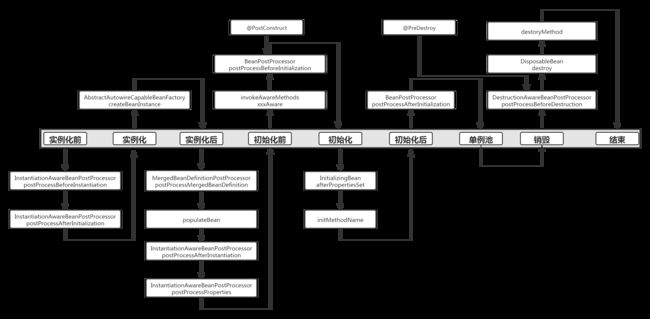spring源码系列7——spring启动流程5
前面系列6分析了Bean的实例化过程,本节分析初始化过程。发车!
1、doCreateBean
protected Object doCreateBean(String beanName, RootBeanDefinition mbd, @Nullable Object[] args)
throws BeanCreationException {
// Instantiate the bean.
BeanWrapper instanceWrapper = null;
if (mbd.isSingleton()) {
instanceWrapper = this.factoryBeanInstanceCache.remove(beanName);
}
if (instanceWrapper == null) {
//通过反射创建实例
instanceWrapper = createBeanInstance(beanName, mbd, args);
}
Object bean = instanceWrapper.getWrappedInstance();
Class<?> beanType = instanceWrapper.getWrappedClass();
if (beanType != NullBean.class) {
mbd.resolvedTargetType = beanType;
}
// Allow post-processors to modify the merged bean definition.
synchronized (mbd.postProcessingLock) {
if (!mbd.postProcessed) {
try {
//@Autowired、@Resourse等注解通过此处解析出所依赖的bean
applyMergedBeanDefinitionPostProcessors(mbd, beanType, beanName);//关键步骤1
}
catch (Throwable ex) {
//省略非关键代码
}
//标记已经经过MergedBeanDefinitionPostProcessors处理
mbd.postProcessed = true;
}
// Eagerly cache singletons to be able to resolve circular references
// even when triggered by lifecycle interfaces like BeanFactoryAware.
//判断当前bean是否需要提前暴露
boolean earlySingletonExposure = (mbd.isSingleton() && this.allowCircularReferences &&
isSingletonCurrentlyInCreation(beanName));
if (earlySingletonExposure) {
if (logger.isTraceEnabled()) {
logger.trace("Eagerly caching bean '" + beanName +
"' to allow for resolving potential circular references");
}
//将当前bean加入三级缓存
addSingletonFactory(beanName, () -> getEarlyBeanReference(beanName, mbd, bean));//关键步骤2
}
// Initialize the bean instance.
Object exposedObject = bean;
try {
//填充bean
populateBean(beanName, mbd, instanceWrapper);//关键步骤3
//执行实例化方法
exposedObject = initializeBean(beanName, exposedObject, mbd);//关键步骤4
}
catch (Throwable ex) {
//省略非关键代码
}
if (earlySingletonExposure) {
//省略非关键代码
}
// Register bean as disposable.
try {
//注册销毁回调
registerDisposableBeanIfNecessary(beanName, bean, mbd);
}
catch (BeanDefinitionValidationException ex) {
throw new BeanCreationException(
mbd.getResourceDescription(), beanName, "Invalid destruction signature", ex);
}
return exposedObject;
}
以上主要流程可以拆解为4步,下面逐一分析:
- 关键步骤1
protected void applyMergedBeanDefinitionPostProcessors(RootBeanDefinition mbd, Class<?> beanType, String beanName) {
for (BeanPostProcessor bp : getBeanPostProcessors()) {
if (bp instanceof MergedBeanDefinitionPostProcessor) {
MergedBeanDefinitionPostProcessor bdp = (MergedBeanDefinitionPostProcessor) bp;
bdp.postProcessMergedBeanDefinition(mbd, beanType, beanName);
}
}
}
下面的类都实现MergedBeanDefinitionPostProcessor接口:
@Resource—CommonAnnotationBeanPostProcessor
@PostConstruct—CommonAnnotationBeanPostProcessor
@PreDestroy—CommonAnnotationBeanPostProcessor
@Autowired—AutowiredAnnotationBeanPostProcessor
@value—AutowiredAnnotationBeanPostProcessor
其中CommonAnnotationBeanPostProcessor类有两个作用:
A、处理@PostConstruct和@PreDestroy注解,用LifecycleMetadata表示初始化方法和销毁时的回调方法。
private class LifecycleMetadata {
private final Class<?> targetClass;
private final Collection<LifecycleElement> initMethods;
private final Collection<LifecycleElement> destroyMethods;
@Nullable //描绘@PostConstruct所对应方法
private volatile Set<LifecycleElement> checkedInitMethods;
@Nullable //描绘@PreDestroy所对应方法
private volatile Set<LifecycleElement> checkedDestroyMethods;
省略非关键代码
}
B、@Resource注解:找出@Resource注解所注入的元素,并用InjectedElement表示所需要注入的元素。
public class InjectionMetadata {
private static final Log logger = LogFactory.getLog(InjectionMetadata.class);
private final Class<?> targetClass;
private final Collection<InjectedElement> injectedElements;
//注入的元素
@Nullable
private volatile Set<InjectedElement> checkedElements;
//省略非关键代码
}
AutowiredAnnotationBeanPostProcessor类主要找出@Autowired和@Resource注解所注入的元素并用InjectionMetadata 进行表示,此处不再列举。
- 关键步骤2
boolean earlySingletonExposure = (mbd.isSingleton() && this.allowCircularReferences
&&isSingletonCurrentlyInCreation(beanName));
this.allowCircularReferences 默认为true;
isSingletonCurrentlyInCreation判断当前类是否在创建中;如果都为true,则代表需要提前暴露,则加入三级缓存;
protected void addSingletonFactory(String beanName, ObjectFactory<?> singletonFactory) {
synchronized (this.singletonObjects) {
//单例池不包含当前beanName
if (!this.singletonObjects.containsKey(beanName)) {
//放入三级缓存
this.singletonFactories.put(beanName, singletonFactory);
this.earlySingletonObjects.remove(beanName);
this.registeredSingletons.add(beanName);
}
}
}
剩下的关键步骤3和4将在标题2和标题3分析。
2、populateBean
protected void populateBean(String beanName, RootBeanDefinition mbd, @Nullable BeanWrapper bw) {
//省略非关键代码
if (!mbd.isSynthetic() && hasInstantiationAwareBeanPostProcessors()) {
for (BeanPostProcessor bp : getBeanPostProcessors()) {
if (bp instanceof InstantiationAwareBeanPostProcessor) {
//InstantationAwareBeanPostProcessor
InstantiationAwareBeanPostProcessor ibp = (InstantiationAwareBeanPostProcessor) bp;
//执行InstantiationAwareBeanPostProcessor的postProcessAfterInstantiation方法
if (!ibp.postProcessAfterInstantiation(bw.getWrappedInstance(), beanName)) {
//关键步骤1
return;
}
}
}
}
/**
* int AUTOWIRE_NO = 0;
* 目前非xml都是使用这种,需要开发者手动注入,比如用@Autowired。
*
* int AUTOWIRE_BY_NAME = 1;
* 根据名字注入,需要写set方法。比如setXX(YY yy)方法,spring按set方法名字(XX)去容器查找bean并注入。
*
* int AUTOWIRE_BY_TYPE = 2;
* 根据类型注入,需要写set方法。比如setXX(YY yy) spring按set方法里面的参数类型YY去容器中查找bean
*
* int AUTOWIRE_CONSTRUCTOR = 3;
* 构造注入
*/
PropertyValues pvs = (mbd.hasPropertyValues() ? mbd.getPropertyValues() : null);
int resolvedAutowireMode = mbd.getResolvedAutowireMode();
if (resolvedAutowireMode == AUTOWIRE_BY_NAME || resolvedAutowireMode == AUTOWIRE_BY_TYPE) {
//关键步骤2
MutablePropertyValues newPvs = new MutablePropertyValues(pvs);
if (resolvedAutowireMode == AUTOWIRE_BY_NAME) {
autowireByName(beanName, mbd, bw, newPvs);
}
if (resolvedAutowireMode == AUTOWIRE_BY_TYPE) {
autowireByType(beanName, mbd, bw, newPvs);
}
pvs = newPvs;
}
boolean hasInstAwareBpps = hasInstantiationAwareBeanPostProcessors();
boolean needsDepCheck = (mbd.getDependencyCheck() != AbstractBeanDefinition.DEPENDENCY_CHECK_NONE);
PropertyDescriptor[] filteredPds = null;
if (hasInstAwareBpps) {
if (pvs == null) {
pvs = mbd.getPropertyValues();
}
for (BeanPostProcessor bp : getBeanPostProcessors()) {
if (bp instanceof InstantiationAwareBeanPostProcessor) {
InstantiationAwareBeanPostProcessor ibp = (InstantiationAwareBeanPostProcessor) bp;
//处理@Autowired、@Resource等注解注入,根据MergedBeanDefinitionPostProcessor所找出的InjectionMetadata元素,从容器中找出所依赖bean注入
PropertyValues pvsToUse = ibp.postProcessProperties(pvs, bw.getWrappedInstance(), beanName);//关键步骤3
if (pvsToUse == null) {
if (filteredPds == null) {
filteredPds = filterPropertyDescriptorsForDependencyCheck(bw, mbd.allowCaching);
}
pvsToUse = ibp.postProcessPropertyValues(pvs, filteredPds, bw.getWrappedInstance(), beanName);
if (pvsToUse == null) {
return;
}
}
pvs = pvsToUse;
}
}
}
//省略非关键代码
if (pvs != null) {
//xml方式注入属性
applyPropertyValues(beanName, mbd, bw, pvs);
}
}
以上流程可以拆解成3步:
-
关键步骤1
InstantiationAwareBeanPostProcessor——>postProcessAfterInstantiation; -
关键步骤2
autowireMode的处理:
int AUTOWIRE_NO = 0;
//目前非xml都是使用这种,需要开发者手动注入,比如用@Autowired。int AUTOWIRE_BY_NAME = 1;
//根据名字注入,需要写set方法。比如setXX(YY yy)方法,spring按set方法名字(XX)去容器查找bean并注入。int AUTOWIRE_BY_TYPE = 2;
//根据类型注入,需要写set方法。比如setXX(YY yy) spring按set方法里面的参数类型YY去容器中查找beanint AUTOWIRE_CONSTRUCTOR = 3;
//构造注入 -
关键步骤3
InstantiationAwareBeanPostProcessor——>postProcessProperties
针对前面MergedBeanDefinitionPostProcessor解析出来的InjectionMetadata,从容器中查找bean实现注入;
3、initializeBean
protected Object initializeBean(String beanName, Object bean, @Nullable RootBeanDefinition mbd) {
if (System.getSecurityManager() != null) {
//省略非关键代码
}
else {
//执行Aware接口—BeanNameAware BeanClassLoaderAware BeanFactoryAware
invokeAwareMethods(beanName, bean);//关键步骤1
}
Object wrappedBean = bean;
if (mbd == null || !mbd.isSynthetic()) {
//BeanPostProcessor before处理,比如执行@PostConstruct标记的方法
wrappedBean = applyBeanPostProcessorsBeforeInitialization(wrappedBean, beanName);//关键步骤2
}
try {
//InitializingBean init-method方法
invokeInitMethods(beanName, wrappedBean, mbd);//关键步骤3
}
catch (Throwable ex) {
//省略非关键代码
}
if (mbd == null || !mbd.isSynthetic()) {
//BeanPostProcessor after aop
wrappedBean = applyBeanPostProcessorsAfterInitialization(wrappedBean, beanName);//关键步骤4
}
return wrappedBean;
}
以上流程可以拆解成4步:
-
关键步骤1
xxxAware执行———BeanNameAware、BeanClassLoaderAware、BeanFactoryAware -
关键步骤2
BeanPostProcessor——postProcessBeforeInitialization 比如处理@PostConstruct -
关键步骤3
invokeInitMethods——InitializingBean接口、init-method -
关键步骤4
BeanPostProcessor——postProcessAfterInitialization
比如处理aop
4、bean生命周期
bean生命周期分广义和狭义,广义指从bean定义(注解、xml)解析成beanDefinition,以及从beanDefinition生成bean的整个过程。而狭义主要从beanDefinition生成bean的过程。 外层的框则代表广义生命周期,内层的框则代表狭义生命周期。
外层的框则代表广义生命周期,内层的框则代表狭义生命周期。
狭义bean的生命周期如下:

通过分析bean的生成过程得到生命周期,通过生命周期得到拓展点,从而可以控制bean的生成,为我所用。
5、总结
通过从系列3到系列7总共5篇文章分析bean的整个生成过程,得到bean的生命周期,通过分析生命周期可以得到bean的拓展点,从而可以控制bean的生成。前面流程只是分析了主流程,部分细节尚需继续研究,比如循环依赖、构造函数的选择、factoryBean、重要注解(@Autowired、@Resource、@PostConstruct等注解分析),敬请期待后续系列。